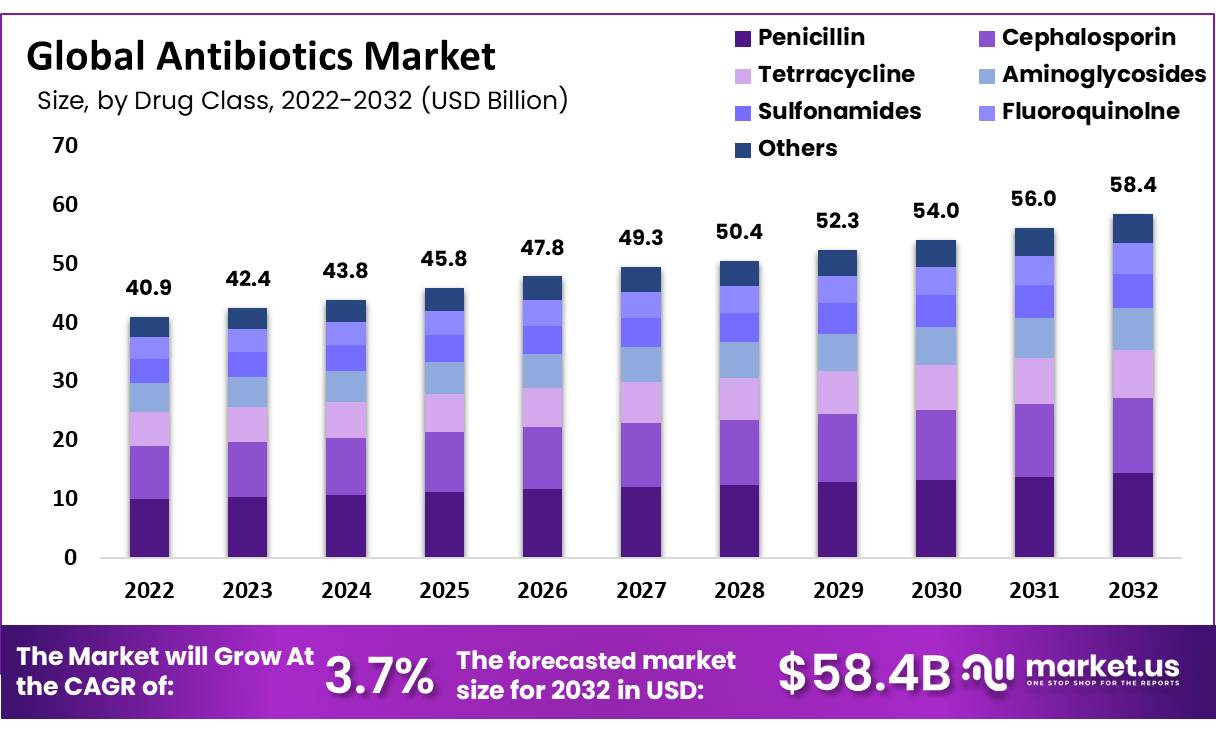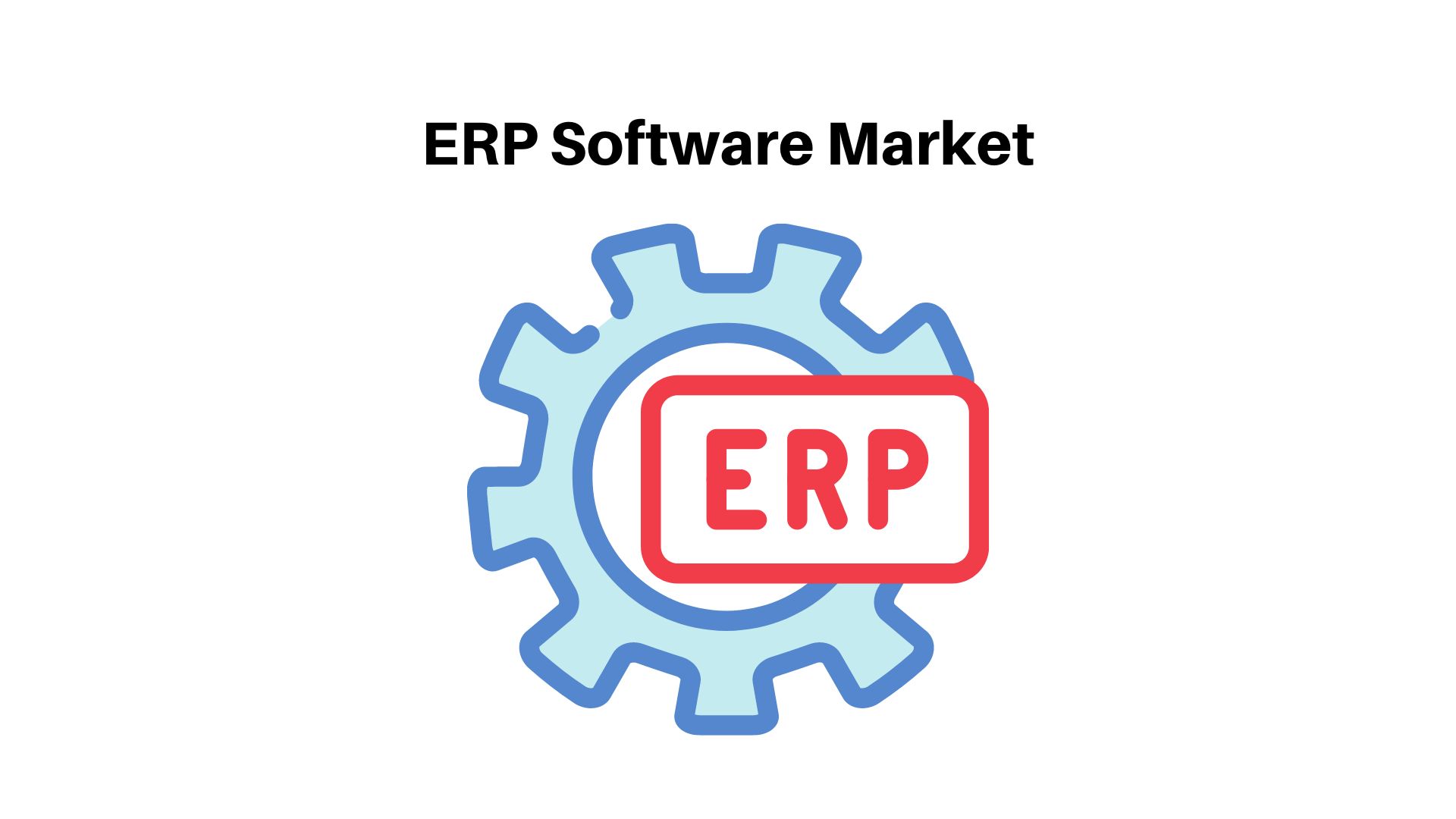Antibiotics Market Projected To Reach a Revised Size Of USD 58.4 Billion By 2032, Growing At A CAGR of 3.7%

Page Contents
Market Overview
Published Via 11Press : The Global Antibiotics Market refers to pharmaceutical drugs known as antibiotics. Antibiotics are drugs prescribed to treat bacterial infections by either killing them off directly or restricting their growth – they play an essential part in modern healthcare and have helped save many lives since being first discovered.
Antibiotics have long been an integral component of the pharmaceutical industry. They include penicillins, cephalosporins, macrolides, fluoroquinolones, and tetracyclines; available as tablets, capsule injections, or topical ointments.
Factors driving the antibiotics market include the increasing prevalence of bacterial infections and rising levels of antibiotic-resistant bacteria; an expanding global population; however, challenges facing this market include the development of resistance, stringent regulatory policies, and high costs related to research and development for antibiotics.
Want a bigger picture? Try a PDF sample of this report now @ https://market.us/report/antibiotics-market/request-sample/
[See the complete table of contents and list of exhibits, as well as selected illustrations and example pages from this report]

Key Takeaway
- Importance in healthcare: Antibiotics play an indispensable role in treating bacterial infections and saving lives, constituting an integral component of modern medicine used across various healthcare settings.
- Market Growth Drivers: The antibiotics market is driven by factors including an increased prevalence of infections, antibiotic resistance emerging across bacteria strains, and an expanding global population that drives demand for effective antibiotic treatments. These drivers also drive innovation within this space to meet rising expectations from healthcare consumers worldwide.
- Antibiotic Resistance Challenge: Antibiotic-resistant bacteria pose a formidable challenge to the market for antibiotics. Overuse or misuse, and lack of new development of new antibiotics contribute to their resistance; developing innovative solutions against it is of vital importance in this arena.
- Research and development: Pharmaceutical companies make substantial investments in research and development to discover new antibiotics or improve existing ones, but the process of antibiotic development can be long and expensive, necessitating significant investments as well as regulatory hurdles to be navigated successfully.
- Competitive landscape: The antibiotics market is intensely competitive, featuring major pharmaceutical companies competing with each other to produce and distribute antibiotics.
Regional Snapshot
- North America: North America has long been one of the leading markets for antibiotics. This region's extensive healthcare infrastructure and use of antibiotics make for an enviable market environment; with several leading pharmaceutical firms located here. The United States stands out as a key contributor, having several of its own pharmaceutical giants located here as major market players.
- Europe: Europe represents another significant market for antibiotics. Countries such as Germany, France, and the UK boast robust healthcare systems that consume antibiotics at high rates; yet concerns over antibiotic resistance in Europe have led to greater efforts toward antibiotic stewardship programs and regulatory actions to promote responsible use.
- Asia-Pacific: The Asia-Pacific region has witnessed explosive growth in the antibiotics market over recent years. China, India, and Japan all boast large populations with rising healthcare expenditures resulting in a greater need for antibiotics; rising incidence of infectious disease coupled with rising resistance pose additional threats in this part of the world; however, governments in these nations are taking measures to enhance access and regulate antibiotic usage to address such challenges as well.
- Latin America: Latin America is an emerging market for antibiotics. Boasting an ever-increasing population and urbanization rates, as well as improved healthcare infrastructure, Brazil and Mexico have emerged as two of the largest markets. Demand for antimicrobial medications due to infectious disease outbreaks present within this region continues to surge while access to healthcare and antibiotic stewardship programs are areas for further advancement within this continent.
- Middle East and Africa: Antibiotic use across these regions varies considerably. Some nations enjoy well-developed healthcare systems and high antibiotic consumption rates while others face infrastructure issues as well as infectious disease outbreaks that require antibiotic therapy, making the region susceptible to infectious infections and resistant to treatment despite efforts being taken to enhance healthcare services and regulate antibiotic consumption.
Drivers
- Increased Prevalence of Bacterial Infections: Bacterial infections have become an increasing global health threat. Their rising incidences, such as respiratory tract infections, urinary tract infections, skin and soft tissue infections, and sepsis drive antibiotic prescription demand. Population growth, changing demographics, and infectious disease transmission all play a part in contributing to an increase in prevalence.
- Antibiotic-Resistant Bacteria: Antibiotic-resistant bacteria have emerged as one of the primary drivers in the global antibiotics market, driven by overuse and misuse of common antibiotics which has led to their ineffective use, leading to an emergence of bacteria resistant to them requiring newer and alternative treatment solutions to combat resistant infections. This trend necessitates new drugs or treatment alternatives being created.
- Global Population Surge: With global populations expanding at an ever-increasing pace, healthcare services and antibiotics, in particular, are in greater demand than ever. More individuals require treatment, and so more effective antibacterials must be available to combat infections and avoid complications.
- Technological Advancements: Technological advancements and pharmaceutical research contribute significantly to the creation of novel antibiotics. Utilizing techniques like genomics, high-throughput screening, computational modeling, etc. – scientists can discover and design effective antibiotics with reduced side effects; driving innovation within the antibiotics market. These technological developments facilitate antibiotic market expansion.
Awareness and Education: Raising awareness among healthcare providers and the general public of appropriate antibiotic use is an integral component of driving the market forward. Education efforts that foster antibiotic stewardship help lower unnecessary prescriptions while simultaneously combatting resistance to these antimicrobials.
Make an inquiry before picking up this report @ https://market.us/report/antibiotics-market/#inquiry
Challenges
- Antibiotic Resistance: One of the greatest challenges posed to global public health today is antibiotic resistance. Overuse and misuse have contributed to resistant strains of bacteria developing immunity against existing antibiotics; consequently limiting their lifespan as treatments while necessitating the development of new ones to combat infections resistant to existing ones.
- Establishing and Exploring New Antibiotics: Antibiotic discovery and development can be an arduous and expensive endeavor for pharmaceutical companies, who face difficulties finding novel compounds and conducting rigorous clinical trials before bringing new antibiotics onto the market. Furthermore, their return on investment tends to be lower compared with other therapeutic areas, leading to diminished focus in this research and development area.
- Regulatory Hurdles: Regulator agencies have implemented stringent regulations and guidelines regarding antibiotic development and usage that aim to ensure patient safety while restricting antibiotic resistance, yet can present significant obstacles for companies navigating them successfully. They pose challenges in terms of time, cost, and resources required to navigate regulatory environments effectively.
- Market Fragmentation: The antibiotics market is fragmented, featuring various manufacturers offering various antibiotic products at differing price points and margins; this fragmentation creates price competition among companies selling antibiotics as well as limited incentives to invest in antibiotic research and development by these same businesses.
Key Players
- Pfizer Inc.
- Abbott
- Sanofi S.A.
- GlaxoSmithKline plc.
- Bayer AG
- Bristol-Myers Squibb Company
- Merck & Co, Inc.
- Johnson & Johnson
- Astellas Pharma Inc.
- Novartis AG
- Melinta Therapeutics
- Bayer Healthcare
- Eli Lilly and Company
- Arixa Pharmaceuticals Inc.
- Other Key Players
Key Market Segments
By Drug Class
- Penicillin
- Cephalosporin
- Tetracycline
- Aminoglycosides
- Sulfonamides
- Fluoroquinolone
- Others
By Application
- Urinary Tract Infections
- Respiratory Infections
- Skin Infections
- Septicemia
- Ear Infection
- Gastrointestinal Infections
- Other Applications
By Route of Administration
- Oral
- Parenteral
- Topical
- Others
By Spectrum of Activity
- Broad-spectrum Antibiotic
- Narrow- spectrum Antibiotic
By Distribution Channel
- Hospital Pharmacy
- Retail Pharmacy
- Online Pharmacy
Other Distribution Channels
Top Impacting Factors
- Antibiotic Resistance: Resistance to antibiotics has an enormously damaging impact on the antibiotics market, with resistant bacteria significantly diminishing existing treatment effectiveness and leading to treatment failures and increasing healthcare costs. Due to this phenomenon, new and alternative strategies must be devised immediately in response to its prevalence – creating more opportunities than before for innovation within this space.
- Prevalence of Infectious Disease: The prevalence of infectious diseases directly drives demand for antibiotics. Factors such as population growth, aging populations, increased urbanization, and travel contribute to infectious disease outbreaks; incidences such as respiratory tract infections, urinary tract infections, or bloodstream infections generate demand.
- Healthcare Infrastructure and Access: Healthcare infrastructure and accessibility play an essential part in antibiotic usage. Regions with strong healthcare systems and access to appropriate diagnostics tend to use antibiotics responsibly and strategically while areas with limited healthcare resources could experience difficulty controlling overuse or misuse, leading to inaccurate prescriptions and overuse or misuse.
- Regulatory Framework: Antibiotic regulatory environments play a significant role in shaping their markets. Stringent regulations, guidelines, and policies pertaining to development, approval, and usage affect availability, pricing, and accessibility; accordingly, frameworks that promote responsible use including antimicrobial stewardship programs as well as surveillance systems are crucial tools in effectively overseeing markets.
Recent Developments
- Antibiotic Stewardship Programs Have Gained Momentum: Antibiotic stewardship programs have seen rapid expansion over the years. Their goal is to encourage the responsible use of antibiotics, optimize treatment regimens and decrease resistance development. Healthcare facilities and organizations alike are now adopting guidelines and protocols to ensure appropriate antibiotic prescribing practices.
- Researchers Explore Alternative Approaches to Combat Antibiotic Resistance: Scientists have begun investigating various strategies for fighting antibiotic resistance. This includes creating novel antibiotics with different mechanisms of action and combination therapies as well as repurposing existing drugs; there has also been increasing interest in applying machine learning and genomic technologies in order to target new targets with more effective antibiotics and identify more efficient antibiotic treatments.
- Public Health Initiatives: Governments and international organizations are taking proactive steps to combat antibiotic resistance through public health initiatives. Their goals include raising awareness among healthcare providers, policymakers, and the general public regarding responsible antibiotic use and infection prevention measures – along with the consequences of antibiotic resistance – through public engagement efforts and public campaigns.
- Collaboration and Partnerships: Collaboration among academic institutions, pharmaceutical companies, and government agencies has grown steadily to promote antibiotic research and development. Public-private partnerships have also emerged to facilitate funding, knowledge-sharing and regulatory support of antibiotic development efforts.
Report Scope
| Report Attribute | Details |
| The market size value in 2023 | US$ 40.9Bn |
| Revenue Forecast by 2032 | US$ 58.4Bn |
| Global Market Growth Rate (2023 to 2033) | CAGR Of 3.7% |
| Regions Covered | North America, Europe, Asia Pacific, Latin America, and Middle East & Africa, and Rest of the World |
| Historical Years | 2017-2022 |
| Base Year | 2022 |
| Estimated Year | 2023 |
| Short-Term Projection Year | 2028 |
| Long-Term Projected Year | 2032 |
Frequently Asked Questions
Q: What is the antibiotics market?
A: The antibiotics market refers to the global industry involved in the production, distribution, and sale of antibiotics, which are a class of drugs used to treat bacterial infections in humans and animals.
Q: Why is the antibiotics market important?
A: The antibiotics market plays a crucial role in the healthcare industry by providing effective treatments for bacterial infections. Antibiotics have greatly contributed to improving patient outcomes and reducing mortality rates associated with infectious diseases.
Q: What factors are driving the growth of the antibiotics market?
A: Several factors contribute to the growth of the antibiotics market, including the increasing prevalence of bacterial infections, rising demand for effective treatments, advancements in drug development, and the emergence of antibiotic-resistant strains of bacteria.
Q: Are there different types of antibiotics available in the market?
A: Yes, there are several classes of antibiotics available in the market, including penicillins, cephalosporins, fluoroquinolones, tetracyclines, macrolides, aminoglycosides, and others. Each class has its own mechanism of action and targets specific types of bacteria.
Contact
Global Business Development Team – Market.us
Market.us (Powered by Prudour Pvt. Ltd.)
Send Email: [email protected]
Address: 420 Lexington Avenue, Suite 300 New York City, NY 10170, United States
Tel: +1 718 618 4351
Website: https://market.us
Content has been published via 11press. for more details please contact at [email protected]
The team behind market.us, marketresearch.biz, market.biz and more. Our purpose is to keep our customers ahead of the game with regard to the markets. They may fluctuate up or down, but we will help you to stay ahead of the curve in these market fluctuations. Our consistent growth and ability to deliver in-depth analyses and market insight has engaged genuine market players. They have faith in us to offer the data and information they require to make balanced and decisive marketing decisions.


